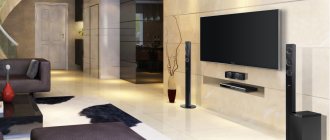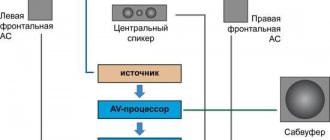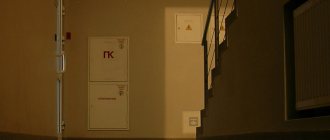A theater, as you know, begins with a hanger, and a serious home theater begins with the requirements for its construction. These requirements can be expressed in numerical values (many parameters are indicated in the standards), but first I propose to define two simple rules for high-quality recreational cinema: 1) The viewer should not see anything other than what is happening on the screen, 2) The viewer should not hear anything other than the soundtrack of the film .
Their implementation guarantees maximum “immersion” for the viewer when watching, because all his attention will be directed to what is happening on the screen, nothing will distract him.
I will return to these rules more than once when describing various aspects of creating a recreation center, but now I will start with the first stage - the stage of building the premises. Under ideal conditions, it is at this stage that the future characteristics of the home theater should be determined.
So, choosing the optimal premises for a recreation center begins, oddly enough, with the budget. The size of the screen depends on the area of the selected room, and the brightness of the projector and the distance to the audience depend on its diagonal, and these distances are important to take into account when choosing speaker systems, because the speakers must produce sound pressure with a margin for sound attenuation on the way to the listener. It is clear that the brightness of a projector greatly affects its price, in turn, acoustics capable of producing high sound pressure are also not cheap and, moreover, require powerful and expensive amplifiers.
Finally, high sound pressure requires increased attention to the quality and accuracy of the acoustic treatment of the room. And so the dependence of the price of a recreation center on the area is non-linear, and if we take acoustic treatment, then the complexity increases in the cube, because if the area doubles, the area of the treated surfaces will increase 8 times! However, according to my observations, the optimal room area for a high-class recreation center for 2-5 seats is 50-80 sq.m. with a ceiling height of 2.5-4 meters.
Isolate and absorb
Acoustic treatment of premises traditionally solves two problems: sound absorption and sound insulation.
In the case of a home theater, with the desired balance of sound absorption in the room, a correct, standard acoustic environment is formed, which significantly reduces the harmful effect of the room on sound (reflections) and creates an acoustic atmosphere similar to that in the recording studio where post-processing was carried out. Those. Ideally, we should hear everything the same and in the same way as the sound engineer heard during the final viewing before the film was released. (For now, we do not take into account issues of the quality of amplification, decoders, speakers, etc.) It is clear that every sound matters - it is not accidentally introduced into the film track, its identical reproduction will give a better understanding of the director’s idea and will ensure the correct artistic perception of the film.
In turn, sound insulation is a significant reduction in external noise penetrating into the home theater. A better signal-to-noise ratio means a wider dynamic range, and the latter is directly related to the realism of perception. Soundproofing, in addition, prevents the viewer from hearing other extraneous sounds from other rooms that will distract him from watching. Finally, there's the matter of protecting the rest of the house from the sounds of a home theater running at full power.
In addition to soundproofing the room itself, a separate task is to muffle various equipment: air conditioners, powerful amplifiers with humming transformers, a projector, etc. A particularly noisy projector is often placed in a separate box, the components are placed in a specially designated cabinet or even a separate equipment room. At the same time, the equipment indicators, again, will not distract the viewer.
All the pros and cons of installing a TV
It is much easier to assemble a home theater with your own hands when you already have a modern wide-diagonal TV at home. In addition to this factor, there are a number of special advantages of a TV over a projector:
- high-quality, bright, contrast and clear image;
- lighting in the room does not affect the quality of the picture;
- you can watch movies without a speaker system;
- ease and simplicity of setup and management;
- durability.
There are no comments regarding the functionality of the TV. Modern devices cope with their intended purpose perfectly well. But there are other aspects in which they lose to projectors:
- wide-diagonal TVs are not a cheap pleasure;
- greater load on the visual apparatus compared to the projector;
- the TV screen takes up quite a lot of space;
- limiting the image size to the TV diagonal;
- limited viewing angles.
It is also worth choosing equipment based on what it will be used for. If you are planning to assemble a home theater with your own hands to watch TV shows, then you should opt for a TV. And if the home theater will primarily be used for watching movies from satellite television or from Blu-ray media, then it would be more advisable to purchase or make a projector.
In the basement
The best place for a recreation center in the house is the basement. It’s easy to darken such a room (don’t forget about the illuminated sign with the inscription “Entrance”, illumination of the floor and steps), natural sound insulation immediately solves almost all the problems of sealing the room, the only questions that remain are the air supply through the ventilation ducts, doors and ceiling. To reduce the noise level outside such a recreation center, special configurations of muffled ventilation ducts and soundproofing doors with a vestibule are used.
However, there are also unobvious problems with placing a cinema in the basement. For example, due to the fact that almost all materials used for acoustic treatment have excellent thermal insulation characteristics, we will get a “thermos”, while a good DC can have a thermal output of several kilowatts. In other words, the issue of cooling a recreation center in the basement should be taken as seriously as possible. I have seen projects where the viewing temperature rose so quickly that it was difficult to be there half an hour after the start of the film show.
The next problem with basements is that low frequencies are not absorbed by the concrete walls of the basement, but are almost completely reflected back into the room. Under such conditions, the room behaves like a high-quality resonator, and as a result, the amplitudes of parasitic resonances can exceed the useful signal by 15-20 dB! And since the low frequencies decay slowly, they continue to “play” long after the main signal has ended.
There are few effective materials for sound absorption at low frequencies, they are expensive and a lot of them are required. So, in order to effectively dampen concrete walls at frequencies below 80-100 Hz, multilayer structures will be required, the principle of operation, by the way, being similar to multilayer armor, when viscous reflective and absorbing layers alternate with each other. The viscous layer partially transmits low frequencies and simultaneously converts sound into heat (sound waves cause the material to bend and vibrate), and the absorbing layer of porous blown material dampens interlayer reflections and, in turn, converts air movement in the pores of the material into heat.
There is one universal solution for suppressing low-frequency resonances. Concrete walls are lined with double sheets of gypsum fiber board with a vibration-damping gasket between them, and the resulting cavity is filled with porous or fibrous sound-absorbing material, for example, mineral wool. Then sheets of common acoustic materials such as foam rubber, Heradesign panels, etc. are glued onto these false walls made of gypsum plasterboard. - this is already required to obtain the correct level of absorption in the mid- and high-frequency ranges. In the fight against “walking” bass, you need to pay most attention to the rear wall, where the first reflection of the sound wave coming from the front speakers and subwoofers is formed.
There is also the so-called SBIR effect (Speaker Boundary Interference Response). Its essence is that the first reflections from a nearby wall come to the viewer with some delay in relation to the direct sound, and certain frequencies are in antiphase. As a result, there is a strong dip in the frequency response. To avoid this problem, all high-class recreation centers are built on built-in acoustics, so that the speaker diffusers are in the plane of the wall, then there will be no conditions for the occurrence of the SBIR effect.
What is an audio decoder?
This is a device designed to convert digital audio to analog. As a rule, there are three outputs on the front panel of the device: optical, coaxial and USB. It is clear that on this side there is a connection between the decoder and the TV, tuner, and so on. On the rear panel there are six outputs for the speakers of the speaker system and a video output for the TV. Sometimes the coaxial output may not be on the front panel of the audio decoder, but on the rear.
The process of connecting a speaker system can be summarized in a few simple steps:
- We connect the sound source to the audio decoder using a fiber-optic cable through the appropriate output.
- Using six RCA cables we connect the decoder to the speaker system.
- Using the remote control that comes with the audio decoder, select the desired input (optical, coaxial or USB).
- We test the speaker system and enjoy the high-quality sound.
An old speaker system can still work for many years. Moreover, the sound quality in it is much better than in Chinese plastic speakers. Therefore, the age of some electrical appliances is not at all a reason to drag them to a landfill.
Algorithms
Recently, the so-called “active systems”, when the task of controlling room reflections is taken on by a special sound processor. It is very effective precisely in the low-frequency range, where acoustics alone do not allow achieving the desired result. In fact, they help reduce the cost of “passive” acoustic treatment of a room due to this combination, when the processor is responsible for low frequencies of 100-1000 Hz, and higher results are achieved by “architectural” methods. In my opinion, this way the best result is achieved.
Most dedicated sound processors use a parametric equalizer that is carefully tuned to suppress specific room resonances. Moreover, processors of different categories have parametric equalization, from mass models to premium ones, such as ADA, JBL Synthesis, Theta Digital and others. However, “parameters” also have their drawbacks, which limit the scope of such processing. First of all, according to its operating principle, the equalizer reduces the resonance amplitude by “cutting out” a very narrow signal band, which sometimes literally leads to the disappearance of individual notes. In addition, if used incorrectly, a parametric equalizer can easily add serious phase distortion to the system. It is difficult to set up such a system well - you need a lot of experience.
There are other types of audio processing that control room reflections with high precision. For example, processors from the French company Trinnov Audio have proprietary algorithms that suppress reflections without affecting the useful signal. The technology can be briefly described as follows: at the calibration stage, the processor measures all reflections in detail, and then mixes the same “reflections” into the main signal, but only in antiphase. The sounds cancel each other out, but the useful signal does not change.
Acoustic system
Unfortunately, the widespread stereophonic speaker system for a home theater is not suitable, because... it will not create decent surround sound. At home, a 5.1 system is ideal, providing surround sound with four channels, additional single-channel clear speech reproduction and enhanced bass. Multichannel audio provides a complete perception of the film or video program you are watching.
Special attention should be paid to the selection of the acoustic system. For ideal sound, the room where you plan to install the recreation center must be acoustically prepared. Manufacturers of audio equipment present a huge range of devices that differ in the type of acoustic design, size, housing, design and integration.
Of course, today there are speaker systems with large separation (up to 10 channels), but a five-channel design is quite sufficient for the home. More important than the number of additional channels is the output power of the system, which must be in excess of the volume of the room. A rough calculation of the required total “sound” power can be made using the dependence 10 W/1 m2.
The Wharfedale Obsidian 600 5.0 passive speaker system produces good sound and can be an excellent solution for a middle-class home theater.
To make it easier to assemble a DC, you should buy an active speaker system, which has its own amplifier, balanced in power and frequency response with dynamic heads. When purchasing passive speakers, problems with selecting an amplifier cannot be avoided, because it will be necessary to organically match them in terms of power and amplitude-frequency characteristics.
It is worth paying attention to the interface panel of the active speaker system, because not all models have the same inputs. It is very important to choose a model with separate inputs for each channel, because It is preferable to connect it to a signal source in 5.1 format.
The sound should fill the room completely, and not just around the perimeter. Sound positioning is the most accurate sign of high quality and correctly installed equipment.
Acoustic systems can be divided into several standards:
- Three-channel DOLBY SURROUND system with conventional audio coding. They may contain four or more columns.
- Four-channel DOLBY SURROUND PROLOGIC standard with five high-frequency and one low-frequency speakers (subwoofer). It differs from the previous one by an additional speech column.
- Digital systems DTS and DOLBY DIGITAL. These standards represent separate audio channels for each speaker with digital signal encoding.
Purchasing an already assembled speaker system and player will save you from headaches during setup and assembly, however, this solution has its drawbacks - the quality of the sound and settings will be an order of magnitude lower. More suitable for beginners. Panasonic SC-BTT195
Important:
Despite the fact that the active 5.1 speaker system has its own decoder for channel separation from a stereo signal, to improve the quality of sound special effects, it is more advisable not to hardware channel separation, but to software, which is achieved only at the signal source.
Room question
Let me return to the “room issue”. Not everyone has the opportunity to place a home theater in the basement; moreover, the cinema room is often combined with the living room. This is not a very good option, but sometimes there are no others. Here, windows, doorways, plasterboard partition walls and furniture will interfere with obtaining a good sound picture, and, of course, it will be very difficult to obtain good sound insulation. Therefore, for a recreation center, it is better to choose a room without windows, with one door, and which has a minimum of common walls with the living premises. I note that problems with sound insulation are reduced by half if the recreation center is placed in a room on the first or last floor.
The problems of sound absorption, as in the case of a recreation center with a basement, are solved in a similar way, only here it will additionally be necessary to hang heavy light-proof curtains on the windows. Lightweight plasterboard partitions can cause serious problems with the frequency response - a dip will appear at the resonance frequency of this very partition. As a result, it will need to be further strengthened or replaced with a rigid one - brick, foam concrete, etc., in order to eliminate such phenomena.
TV or projector?
To decide how to make a home theater with your own hands, you need to choose a device through which the image will be projected. There are only two options here: TV or projector. If the goal is to bring the atmosphere of a cinema as close as possible to home conditions, then, of course, you should opt for a projector. On the other hand, a TV with a wide diagonal is available in almost every home, so why buy or make other devices? To make it easier for you to make your choice, here are the advantages and disadvantages of both devices.
Plus stereo
Very often, a home theater and stereo are combined in the same room, but the acoustic processing requirements for these two types of systems are significantly different. If for stereo it is necessary that the room is not very muffled and the listener can easily understand what space he is in, then in the case of a recreation center one must strive to almost completely get rid of room reflections. Imagine a dialogue scene in the desert, and you can clearly hear the room - the feeling of immersion will immediately disappear. What to do in such a situation?
Almost all processor-receivers have a music mode for working in stereo - reverberation will be added to the signal, which will go to the rear and surround speakers. This is the best solution for a recreation center combined with a stereo setup in one room, which is acoustically treated for a cinema.
Finally, another case of special acoustic treatment is the use of dipole speakers (rear or side). Since they use reflections from the walls, it is contraindicated to dampen the rear of the room; the main sound absorption is transferred to the front.
Continuation: Building a home theater: choosing acoustics, installing and configuring them (part 2)
What does it take to create a home theater?
To make a home theater with your own hands in its classical sense, you need to decide on the equipment. The simplest and most uncomplicated system should consist of the following elements:
- devices for watching movies (TV/projector);
- devices for sound reproduction (sound system);
- signal source.
Naturally, it is simply impossible to assemble all these devices manually. Of course, if you are an unrecognized genius at assembling household appliances, then anything is possible for you. But for the average user, you will need some components that you still have to buy. Let's not get ahead of ourselves and consider all the elements of a home theater in order.
Eliminating bounce
Bass boom is a common problem that can often be resolved by simply moving the subwoofer a short distance. It should not be installed in corners or near walls. If this doesn't work, placing upholstered furniture and even open bookcases in the corners of the room can be helpful.
Nothing makes windows rattle like a subwoofer, but some things vibrate at higher frequencies at high volumes.
With the music turned up to maximum, you should walk around the room looking for vibrating objects. The sound of the system will be much improved if Smaug's terrifying roar is not accompanied by the noise of a baby rattle forgotten in the room.











